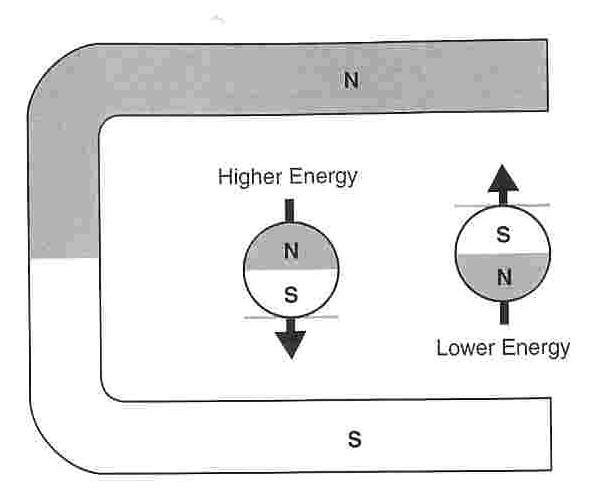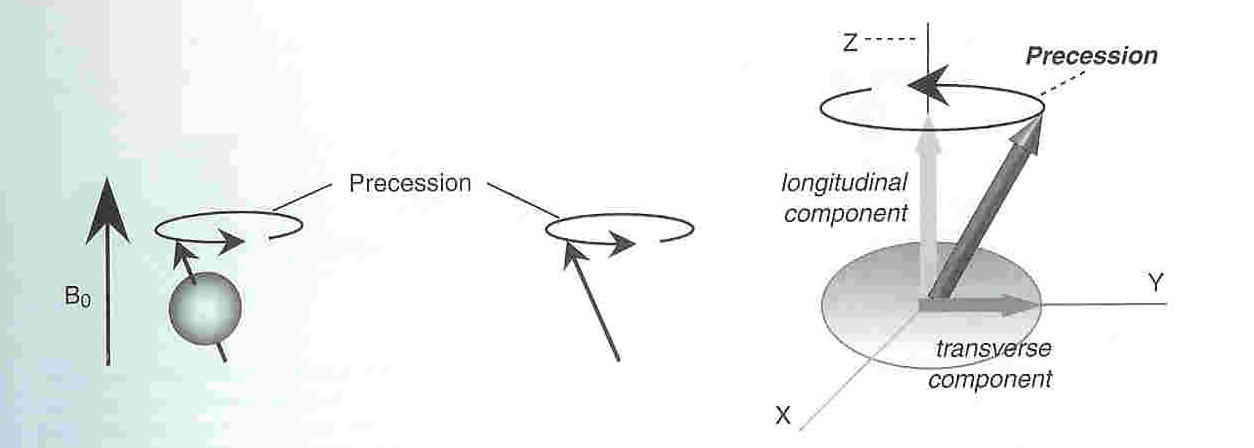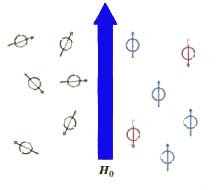| HOME |
MRI BASICS |
fMRI BASICS |
fMRI & ADD/ADHD |
REFERENCES |
This page provides an introduction to several of the physical principles underlying MRI and fMRI.
Click on the links below to be directed to any of these topics.
Electricity and Magnetism
Applied Magnetic Fields
Stable Systems - Energy Minimization
Magnetic Dipoles of Atomic Nuclei
Nuclei and Applied Magnetic Fields
Precession
ELECTRICITY
AND MAGNETISM
Electricity and Magnetism are inextricably linked. Electric fields induce magnetic fields. Electric field is the electric force per unit charge. Electric field is defined in terms of the force it would exert on a positive test charge. Thus, electric fields are directed away from positive charges and toward negative charges. Magnetic field is defined as a force acting on a moving charge. Thus, magnetic field is not a phenomenon which can be independently observed. No material is known to independently produce a magnetic field. Instead, an electric current or changing electric field induces a magnetic field. The magnetic field acts perpendicular to both the velocity of the electric charge (direction of the electric field) and the magnetic force. The direction of the magnetic force is given by the right hand rule. This means that magnetic and electric fields always exist at right angles to one another. The video clip below shows this perpendicular arrangement.
Magnetic and electric force collectively form electromagnetic force and are together described by the Lorentz Force Law. Electromagnetic force is the second strongest of the fundamental forces and is responsible for holding atoms and molecules together. This important connection between electric and magnetic fields means that altering the electric field, perhaps by changing the electric current, will alter the magnetic field. Along similar lines, altering the magnetic field will impact the electric field. In the context of an atom, it is important to note that electric fields only exist with respect to protons and electrons. Neutrons have no electric field as they possess no electric charge. Thus altering the magnetic field of or around an atom will only impact the protons and electrons.
Electricity and Magnetism are inextricably linked. Electric fields induce magnetic fields. Electric field is the electric force per unit charge. Electric field is defined in terms of the force it would exert on a positive test charge. Thus, electric fields are directed away from positive charges and toward negative charges. Magnetic field is defined as a force acting on a moving charge. Thus, magnetic field is not a phenomenon which can be independently observed. No material is known to independently produce a magnetic field. Instead, an electric current or changing electric field induces a magnetic field. The magnetic field acts perpendicular to both the velocity of the electric charge (direction of the electric field) and the magnetic force. The direction of the magnetic force is given by the right hand rule. This means that magnetic and electric fields always exist at right angles to one another. The video clip below shows this perpendicular arrangement.
Magnetic and electric force collectively form electromagnetic force and are together described by the Lorentz Force Law. Electromagnetic force is the second strongest of the fundamental forces and is responsible for holding atoms and molecules together. This important connection between electric and magnetic fields means that altering the electric field, perhaps by changing the electric current, will alter the magnetic field. Along similar lines, altering the magnetic field will impact the electric field. In the context of an atom, it is important to note that electric fields only exist with respect to protons and electrons. Neutrons have no electric field as they possess no electric charge. Thus altering the magnetic field of or around an atom will only impact the protons and electrons.
APPLIED
MAGNETIC FIELDS
The application of a magnetic field in the presence of a magnet causes the charged particles in the field to align in one of two ways, with or against the field. With the field means north to south and against the field means north to north or south to south. Charges aligned with the field create a lower energy, higher stability situation whereas charges aligned against the field create a higher energy, less stable situation.

The application of a magnetic field in the presence of a magnet causes the charged particles in the field to align in one of two ways, with or against the field. With the field means north to south and against the field means north to north or south to south. Charges aligned with the field create a lower energy, higher stability situation whereas charges aligned against the field create a higher energy, less stable situation.

STABLE SYSTEMS -
ENERGY MINIMIZATION
MAGNETIC DIPOLES OF ATOMIC NUCLEI
NUCLEI AND APPLIED MAGNETIC FIELDS
PRECESSION
Protons have an intrinsic angular momentum or spin. This angular momentum is quantized. Sometimes this concept is described as spin and refers to the particle spinning about a particular axis. Thus when an nucleus (protons) is placed in an applied magnetic field it tends toward aligning itself with the applied magnetic field. This often means realigning its axis of rotation with the magnetic field. However, since angular momentum is quantized it can only take on certain values and is thus unlikely that it will align perfectly with the applied magnetic field.
Angular momentum is the tendency of an object to continue to spin about a particular axis. When a force is applied that would tend to change the spinning object's axis of rotation, the object's angular momentum, by conservation of angular momentum, would tend to oppose the force. The force thus causes a change in the DIRECTION of the angular momentum but not a change in its magnitude. Precession is the manifestation of this change in direction. The applied force or torque acts perpendicular to the objects axis of rotation. Thus the torque produces a change in angular momentum which is perpendicular to the initial angular momentum. Once the object adjusts to the torque, it simply rotates along a new path with the same magnitude. This phenomenon is known as precession. A spinning top is a common example of precession. Gravity applies a torque perpendicular to the spinning of the the top which would tend to cause the top to fall over. Instead of falling over right away the top begins to precess with its axis of rotation following a wider path.

Return to top
The stability of a system is directly proportional
to the energy of the system. Thus system's behavior is generally
reflective of the desire to minimize energy and maximize
stability.
MAGNETIC DIPOLES OF ATOMIC NUCLEI
Atomic nuclei consist of
positively charged protons and neutrons which carry no electric
charge. Thus they carry an overall positive charge. Charged
particles exhibit an electric field and positive charges specifically
exhibit an outwardly radiating electric field. If the charged
particle is in motion, which is true of all atomic species at T > 0
K, a magnetic field is also exhibited.
NUCLEI AND APPLIED MAGNETIC FIELDS
Thus when nuclei are placed in applied magnetic
fields, the
particles' alignment with (N to S) the magnetic field is preferable to
their alignment against (N to N or S to S) as this
provides for a lower energy, greater stability scenario. For
example, nuclei in an applied magnetic field might wish
to "flip" from the higher energy to lower energy configuration.
The
energy required for this "flip" to take place is equal to the energy
difference between the states. By the law of conservation of
energy,
any change in energy must be provided or absorbed by the
environment.
Thus, random "flipping" is unlikely. Collisions between atoms
might
allow some flipping to take place.
PRECESSION
Protons have an intrinsic angular momentum or spin. This angular momentum is quantized. Sometimes this concept is described as spin and refers to the particle spinning about a particular axis. Thus when an nucleus (protons) is placed in an applied magnetic field it tends toward aligning itself with the applied magnetic field. This often means realigning its axis of rotation with the magnetic field. However, since angular momentum is quantized it can only take on certain values and is thus unlikely that it will align perfectly with the applied magnetic field.
Angular momentum is the tendency of an object to continue to spin about a particular axis. When a force is applied that would tend to change the spinning object's axis of rotation, the object's angular momentum, by conservation of angular momentum, would tend to oppose the force. The force thus causes a change in the DIRECTION of the angular momentum but not a change in its magnitude. Precession is the manifestation of this change in direction. The applied force or torque acts perpendicular to the objects axis of rotation. Thus the torque produces a change in angular momentum which is perpendicular to the initial angular momentum. Once the object adjusts to the torque, it simply rotates along a new path with the same magnitude. This phenomenon is known as precession. A spinning top is a common example of precession. Gravity applies a torque perpendicular to the spinning of the the top which would tend to cause the top to fall over. Instead of falling over right away the top begins to precess with its axis of rotation following a wider path.

Return to top
E-mail - kwalsh@gprep.org
